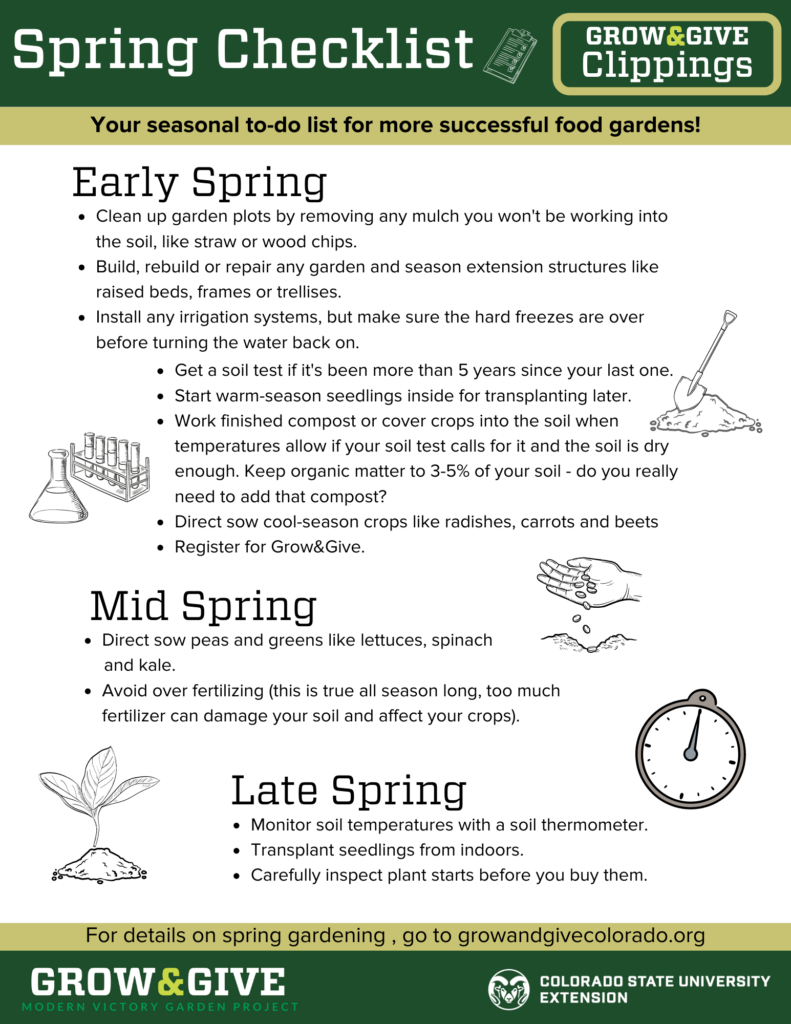Imagine having a thriving garden or farm all year round. Sounds perfect, right?
The secret lies in understanding your soil and giving it the care it needs each season. Enter the “Seasonal Soil Management Checklist” — your ultimate guide to keeping your soil healthy and productive, no matter the weather. As you read on, you’ll discover easy-to-follow steps tailored to each season, ensuring your plants get the best start and continue to flourish.
Ready to transform your soil and boost your garden’s success? Let’s dive into this essential checklist and watch your green space thrive like never before.

Spring Preparation
Preparing your garden for spring involves a crucial checklist for soil management. Ensure soil is rich and ready by checking its pH levels and moisture. Mix organic matter to improve nutrient content and drainage, promoting a healthy growing environment for plants.
Spring is a time of renewal and growth, not just for plants but for the soil that supports them. As the chill of winter fades, it’s time to prepare your garden for the coming season. Spring preparation is crucial for ensuring healthy soil that can nourish your plants throughout the year. With a few simple steps, you can create the ideal environment for your garden to thrive.Assess Soil Health
Start by evaluating the condition of your soil. Is it compacted or loose? Does it drain well? Test its pH level with a simple kit from a garden center. Healthy soil is the foundation of a productive garden. Understanding its current state will guide your next steps.Clear Debris
Remove any leftover leaves, twigs, and dead plants from the winter. These can harbor pests and diseases. Clearing debris also helps the soil breathe and absorb sunlight, warming it up for planting. Make this task a family activity and enjoy the fresh air together.Loosen Soil
Use a garden fork or tiller to gently break up the soil. This process aerates the earth, allowing roots to penetrate more easily. Be careful not to over-till, as it can disrupt beneficial microorganisms. Picture the difference between trying to dig into a hard clay and a fluffy sponge.Add Organic Matter
Incorporate compost or well-rotted manure into your soil. These materials enrich the soil and improve its structure. Organic matter also enhances the soil’s ability to retain moisture, which is vital during dry spells. Imagine each handful of compost as a gift to your soil.Plan Your Garden Layout
Think about what you want to plant this season. Consider crop rotation to prevent soil depletion. Different plants have varying nutrient needs, so rotating can keep your soil balanced. Sketch a rough plan and visualize where each plant will thrive best.Check For Pests
Inspect your garden for signs of pests. Look for holes in leaves or damaged stems. Early detection can save your plants from serious harm later. You might discover critters you never noticed before, but don’t let them surprise you. Spring preparation sets the tone for a fruitful growing season. By investing time in your soil now, you’re setting up a flourishing garden that will reward you in the months to come. What steps will you take to ensure your garden thrives this spring?
Summer Maintenance
Prepare your garden with a seasonal soil management checklist. Identify soil needs, test for nutrients, and adjust pH levels. Ensure your plants thrive by maintaining healthy soil throughout the summer.
Summer is a crucial time for soil management, as the heat and extended daylight can both benefit and challenge your garden. Ensuring your soil is healthy and ready for the summer months can lead to a bountiful harvest. Whether you’re a seasoned gardener or just starting, having a summer maintenance checklist can make all the difference. ###1. Check Soil Moisture Levels
During summer, soils can dry out quickly under the hot sun. Regularly check the moisture level by inserting your finger a few inches into the soil. If it feels dry, it’s time to water. Consider watering early in the morning or late in the afternoon. This reduces evaporation and ensures that your plants get the most benefit from each drop. ###2. Mulch Your Garden Beds
Mulching is a simple yet effective way to conserve soil moisture. Use organic materials like straw, grass clippings, or wood chips to cover your garden beds. A layer of mulch not only retains moisture but also keeps the soil temperature down. Plus, as it breaks down, it enriches the soil with nutrients. ###3. Weed Regularly
Weeds compete with your plants for nutrients, water, and sunlight. Pulling them out regularly can help maintain your garden’s health. Commit to a weekly weeding schedule. It may sound tedious, but it’s a small effort with significant payoff in plant growth and yield. ###4. Monitor Soil Ph
Soil pH can shift during the summer due to factors like watering and plant uptake. Use a simple pH testing kit to keep an eye on it. Most plants thrive in slightly acidic to neutral pH levels. Adjusting pH with lime or sulfur can optimize conditions for your specific plants. ###5. Fertilize Appropriately
Summer is a time of growth, and your plants need nutrients to thrive. Choose a fertilizer that matches your plants’ specific needs. Consider using slow-release fertilizers to provide a steady nutrient supply. This minimizes the risk of nutrient leaching and burning. ###6. Protect Against Soil Erosion
Heavy summer rains can wash away valuable topsoil. Prevent this by planting cover crops or using barriers like stones or logs. Reflect on past summers—did you notice any erosion issues? Addressing them now can save your garden’s future productivity. ###7. Encourage Soil Microbial Life
Healthy soil is alive with beneficial microbes. Encourage this life by adding compost or organic matter. Think of your soil as a living ecosystem. The more vibrant it is, the more it will reward you with a thriving garden. ###8. Plan For Crop Rotation
Consider how your current planting will affect next season’s soil health. Planning ahead can prevent nutrient depletion and pest buildup. Have you tried rotating crops before? It might be the secret weapon your garden needs for long-term success. By following these steps, you’re not just maintaining your soil; you’re investing in a healthier and more productive garden. What’s your next step in preparing your soil for summer?Autumn Assessment
Autumn is a critical time for soil management. As the leaves change color and temperatures drop, you have the perfect opportunity to assess and prepare your soil for the colder months ahead. This season offers a unique chance to evaluate your soil’s health and make necessary adjustments to ensure your garden thrives come spring. Let’s dive into the essential aspects of the autumn assessment.
Check Soil Moisture Levels
Autumn often brings unpredictable weather patterns. It’s vital to check your soil’s moisture levels regularly. Too much rain can lead to waterlogged soil, while too little can leave it dry and unproductive. Use a simple moisture meter or dig a small hole to see how well your soil retains water. Adjust your watering schedule accordingly.
Analyze Soil Nutrients
Test your soil for essential nutrients like nitrogen, phosphorus, and potassium. These are crucial for plant growth and health. You can use a home testing kit or send samples to a local lab for a detailed report. By knowing what your soil lacks, you can add the right fertilizers to enrich it. Imagine the satisfaction of seeing your plants flourish because you took the time to assess and act.
Inspect For Pests
Autumn is not just about beautiful foliage; it’s also a time when pests seek refuge. Check your soil for pests that might affect your plants during winter. Look for signs like holes or unusual spots on leaves. Decide on a plan to manage these pests, whether through natural repellents or other methods. Have you ever considered how much damage can be avoided with early detection?
Evaluate Soil Structure
Assess the physical condition of your soil. Is it compacted or loose? Compacted soil can hinder root growth and water absorption. Aerate your soil by adding organic matter or using garden tools to break it up. Good soil structure is essential for healthy root development. Picture your garden with strong, deep roots supporting a vibrant plant life.
Plan For Soil Amendments
Based on your assessments, plan what amendments your soil needs. Consider adding compost to improve soil texture and fertility. Mulch can protect soil from erosion and maintain temperature. Wouldn’t it be rewarding to know you’re taking steps to prepare your soil for the future?
Autumn assessment provides you with a clear picture of your soil’s current state. By acting now, you pave the way for a successful growing season. What steps will you take this autumn to ensure your soil is in top condition? Your garden’s future starts today, with the choices you make in the fall.

Winter Strategies
Prepare your garden for winter with a seasonal soil management checklist. Check soil pH, add compost, and cover with mulch. These steps help protect and enrich your soil during the colder months.
Winter can be a challenging time for soil management, but it’s also an opportunity to prepare your garden for the coming spring. As temperatures drop, soil becomes dormant and needs specific care to ensure it remains healthy. Implementing effective winter strategies can make a significant difference in the performance of your soil and the success of your future crops.Monitor Soil Moisture Levels
Winter’s unpredictable weather can lead to both overly dry and excessively wet soil. Regularly check moisture levels to prevent these extremes. If the soil is too dry, consider a light watering, but avoid over-saturating to prevent root rot.Apply Mulch
A good layer of mulch can protect your soil from harsh winter conditions. Mulch acts as a barrier, retaining moisture and regulating temperature. Use organic materials like straw, leaves, or wood chips for added nutrients.Cover Crops For Soil Health
Planting cover crops is a smart way to improve soil health during winter. They add organic matter, reduce erosion, and suppress weeds. Consider options like winter rye or clover, which are easy to manage and beneficial.Protect Soil Structure
Heavy rains and snow can compact soil, damaging its structure. Avoid walking on or tilling wet soil to maintain its integrity. Use paths or stepping stones to minimize impact on your garden beds.Test Soil Nutrients
Winter is an ideal time to test your soil’s nutrient levels. This allows you to plan for any amendments needed in spring. Testing kits are widely available and provide valuable insights into the health of your soil.Prepare For Spring Planting
Organize your tools and supplies for the upcoming planting season. Clean and sharpen tools, and start planning your garden layout. Early preparation can reduce springtime stress and improve your garden’s productivity. Have you ever noticed how a little winter prep can transform your spring gardening? By following these winter strategies, you can ensure your soil stays healthy and ready for new growth. What steps are you taking this winter to care for your garden?Conclusion
A well-prepared soil boosts plant health and growth. Each season brings unique challenges. Follow this checklist to keep your soil in top condition. Regular care helps maintain nutrient balance. Healthy soil leads to better harvests. Remember to adjust methods as seasons change.
Listen to your plants and soil. They guide your actions. Consistent effort pays off in the long run. Happy gardening!



